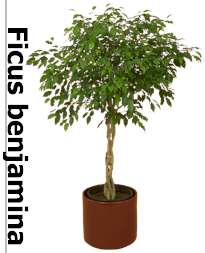Weeping Fig


F. benjamina (weeping fig); F. diversifolia
(mistletoe fig); F. elastica (rubber tree); F. lyrata, also called F. pandurata
(fiddle-leaved fig); F. retusa nitida, also called F. nitida (Indian laurel)
The great popularity of the rubber tree
led plantsmen to search for other species with equal durability under household
conditions. The selections discussed here cover a wide range of sizes,
from types that usually grow less than 1 foot tall to others that can touch
the ceiling unless they are pruned back occasionally. Under humid conditions
many species form roots on their stems; the roots stretch down to the soil,
take hold and form auxiliary trunks.
The weeping fig has 2- to 4-inch-long
pointed shiny leathery leaves and many-twigged slender branches that arch
gracefully. A variety of the weeping fig called F. benjamina 'Exotica',
grows in a pronounced weeping manner, and each of its leaves has a slight
twist that adds to the gracefulness of the plant. Both the basic species
and the variety are usually grown as 4- to 6-foot trees.
The mistletoe fig makes a bushy little
plant, 8 inches to 2 feet tall, with long-lasting leathery dark green leaves.
The leaves, roundish and 1 to 3 inches across, combine with 1/4-inch woody
inedible yellowish red fruit to give the plant the appearance of mistletoe.
The basic rubber tree pleased gardeners
for many years with its glistening dark green oval leaves that open from
pointed rosy sheaths and become 4 to 10 inches long and 2 to 3 inches wide.
But its popularity waned in the late 1940s with the discovery of a type
whose dark green leaves were more broadly oval and had a richer texture--the
broad-leaved rubber tree, F. elastica 'Decora'. Its leaves emerge bronze-colored
from bright red sheaths and grow up to 6 inches wide and 12 inches long;
a prominent central rib is white on top and red on the underside. Another
handsome variety is Doescher's rubber tree, E. elastica 'Doescherii', whose
leaves are the same size as those of the basic rubber tree but are mottled
with gray green, creamy yellow and white; its central ribs and leaf stems
are pink. All types of the rubber tree are usually sold as 2- to 4-foot
plants with one or more trunks. The plants eventually reach ceiling height;
since by that time they will have lost some of their lower leaves, they
should be either pruned or propagated.
The fiddle-leaved fig grows to about the
same size as the rubber tree. Its 12- to 18-inch leaves are shaped like
the body of a violin and have such a gleaming leathery texture that they
always seem freshly waxed.
The Indian laurel, an elegant species,
is often sold as a 4- to 6-foot tree. Its upright branches are densely
clothed with blunt-ended oval dark green leaves, 2 to 4 inches long, that
feel waxy to the touch.
HOW TO GROW. Ficus species do best
in bright indirect or curtain-filtered sunlight; if only artificial light
is available, provide at least 400 foot-candles. Night temperatures of
65° to 70° and day temperatures of 75° to 85° are ideal.
Keep the soil barely moist at all times. Newly purchased or newly potted
plants should not be fertilized for six months; once established, plants
should be fed at six-month intervals. Do not be too quick to repot Ficus
species, for they do very well in relatively small containers even though
their roots are crowded. When the plants become too crowded, as evidenced
by a general lack of flourishing and new leaves that seem stunted, repot
in early spring, using a mixture of 1 part loam, 1 part peat moss or leaf
mold and 1 part sharp sand; to each gallon pailful of this mixture add
1/2 teaspoon of 20 per cent superphosphate, 1 tablespoon of ground limestone
and 2 teaspoons of 5-10-5 fertilizer. Otherwise, use a packaged general-purpose
potting soil. Plants that become too large for their space can be cut back
to within a few inches of the soil in early spring; they will soon make
new growth. Propagate at any season by the method known as air layering.
Watch all ficus for spider mites, mealybugs, and scale insects.
Image from:
http://www.zone10.com/PlantTips/1999/090399.htm